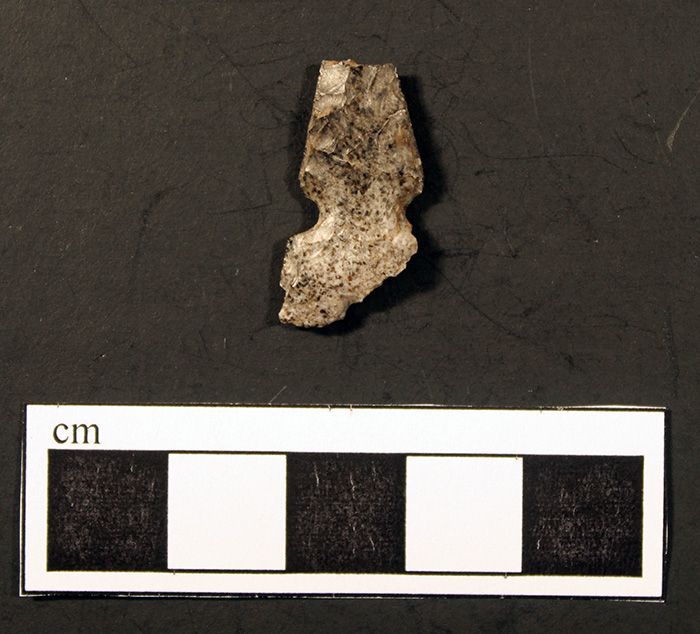Robert J. Scott, Arkansas Archeological Survey - UAPB Research Station
Artifact of the Month - September 2021
In March of 1983, with the assistance of 40 Arkansas Archeological Society members and other volunteers, John House (emeritus UAPB station archeologist) directed salvage efforts at the Barrett mound site in northeast Lee County, Arkansas. Barrett was first recorded in 1940 by Philip Phillips and James A. Ford of the Central Mississippi Valley Archaeological Survey (Phillips et al. 1951). Phillips and Ford documented the presence of four mounds and extensive off-mound scatters of habitation or village debris. The largest mound (Mound A) was recorded as square in shape, 100 feet on a side at its base, with a platform summit that measured 45 feet on a side (House 2017). The site remained unstudied following this first official reporting of its location and major features.

The salvage excavations were prompted after it came to the attention of the Arkansas Archeological Survey in the fall of 1982 that bulldozers were being used to clear trees and other vegetation off of Mound A. The landowners were contacted and it was confirmed that the mound was scheduled to be leveled. They agreed, however, to delay leveling the mound until emergency salvage excavations could be conducted. The project had three goals: “1) preparation of a detailed topographic map of Mound A; 2) elucidation of details of mound construction; and 3) determination of the date of mound construction and the prehistoric culture(s) responsible” (House and House 1987:124).
The project yielded unexpected results. Because the majority of the surface-collected pottery found at the site was grog-tempered, construction and use of the mound was expected to date to the Late Woodland period. Instead, the mound excavations and controlled surface collections yielded shell-tempered pottery and lithic assemblages unlike any previously found in Lee County (House 1996). The presence of “large recurved-rimmed jars with interior red slipping,” a fragment of a funnel, and over 80 pieces of white, Burlington-like chert suggested occupation contemporaneous with the Early Mississippi period Big Lake phase (ca. AD 800–1000) in northeast Arkansas (House and House 1987:131; Rolingson and Mainfort 2002). Elements of the lithic and ceramic collections also pointed to connections with Cahokia in southwest Illinois. The ceramic evidence suggestive of Cahokian influence consisted of two rims from angular-shouldered vessels resembling, in profile, the shape of late eleventh and twelfth century Cahokia-style jars in the American Bottom (House 2017).
The best direct evidence for Cahokia contact at Barrett, however, is a triangular triple-notched arrow point (Figure 1) found in Mound A during the 1983 salvage excavations in a test unit placed near the center of the mound’s summit, at a depth consistent with the third stage (of four) of mound construction. The point is thermally damaged, but was likely made from Burlington chert characteristic of the Crescent Quarry area south of St. Louis in Missouri (Morse and Morse 1983). The distal end (tip) and one corner of the base are broken and missing, but the overall craftsmanship of the point is still apparent. The point is thin, well-made (careful pressure flaking can be seen on both faces), and symmetrical in cross section and outline. Available radiocarbon dates from sites in Illinois and Missouri place the production and use of this variety of Cahokia Notched points between AD 900 and AD 1300 (Justice 1987:233; O’Brien and Wood 1998:237).
Cahokia Notched points made from Burlington-Crescent Quarry chert are rare in Arkansas. In fact, no more than a dozen of these points have been found in all of east Arkansas. Consequently, many of the material culture objects (e.g., Ramey Incised jars) considered to be indicators of direct interaction with Cahokia at the height of its grandeur and influence are rare in Arkansas, and the Mississippi Valley south of Memphis, TN, though there are exceptions (Buchner and Albertson 2020; Jeter et al. 2020). The Barrett site is one of them; it “conforms to a pattern of sites exhibiting evidence of strong Cahokia interaction (e.g., Carson and Winterville in Mississippi, and Lake Providence in Louisiana), being in close proximity to the Mississippi River” (House 2017:12). In 2017, a radiocarbon date was acquired on charcoal from Mound A with a calibrated date range of AD 1020–1185, supporting the hypothesis that the first stages of the construction of Mound A, and the deposition of the Cahokia point within it, occurred during the period of Cahokia’s sudden growth and greatest interregional influence (House 2017; Jeter et al. 2020).
Materials: Thermally damaged, possible Burlington-Crescent Quarry Chert
Dimensions: Max Length 22.6 mm; Max Width 11.1 mm; Blade Notch Width 6.8 mm; Max Thickness 3.0 mm
Weight: 0.8 grams
Age Estimate: ca. A.D. 900 to A.D. 1300
Catalog Number: 1985-511-27
References
Buchner, C. Andrew, and Eric S. Albertson
2020 Cahokia Connections in Northeastern Arkansas. In Cahokia in Context: Hegemony and Diaspora, edited by Charles H. McNutt and Ryan M. Parish, pp. 163–184. University of Florida Press, Gainesville.
House, John H.
1996 East-Central Arkansas. In Prehistory of the Central Mississippi Valley, edited by Charles H. McNutt, pp. 155–186. University of Alabama Press, Tuscaloosa.
2017 A C-14 Date from Barrett Mound A, Lee County. Field Notes 399:9–12.
House, John H., and Rebecca House
1987 Investigating Early Mississippi Period Occupation in the Lower St. Francis Basin, Eastern Arkansas. In The Emergent Mississippian: Proceedings of the Sixth Mid-South Archaeological Conference, June 6–9, 1985. Cobb Institute of Archaeology, Mississippi State University, Starkville.
Jeter, Marvin D., Robert J. Scott, and John H. House
2020 Possible Cahokian Contacts in Eastern and Southeastern Arkansas. In Cahokia in Context: Hegemony and Diaspora, edited by Charles H. McNutt and Ryan M. Parish, pp. 185–204. University of Florida Press, Gainesville.
Justice, Noel D.
1987 Stone Age Spear and Arrow Points of the Midcontinental and Eastern United States: A Modern Survey and Reference. Indiana University Press, Bloomington.
Morse, Dan F., and Phyllis A. Morse
1983 Archaeology of the Central Mississippi Valley. Academic Press, New York.
O’Brien, Michael J., and W. Raymond Wood
1998 The Prehistory of Missouri. University of Missouri Press, Columbia.
Phillips, Philip, James A. Ford, and James B. Griffin
1951 Archaeological Survey in the Lower Mississippi Alluvial Valley, 1940–1947. Papers of the Peabody Museum, Harvard University 25.
Rolingson, Martha A., and Robert C. Mainfort, Jr.
2002 Woodland Period Archaeology in the Central Mississippi Valley. In The Woodland Southeast, edited by David G. Anderson and Robert C. Mainfort, Jr., pp. 20–23. University of Alabama Press, Tuscaloosa.
 Collections and items in our institution have incomplete, inaccurate, and/or missing attribution. We are using this notice to clearly identify this material so that it can be updated, or corrected by communities of origin. Our institution is committed to collaboration and partnerships to address this problem of incorrect or missing attribution. For more information, visit localcontexts.org.
Collections and items in our institution have incomplete, inaccurate, and/or missing attribution. We are using this notice to clearly identify this material so that it can be updated, or corrected by communities of origin. Our institution is committed to collaboration and partnerships to address this problem of incorrect or missing attribution. For more information, visit localcontexts.org.
 The Arkansas Archeological Survey is committed to the development of new modes of collaboration, engagement, and partnership with Indigenous peoples for the care and stewardship of past and future heritage collections.
The Arkansas Archeological Survey is committed to the development of new modes of collaboration, engagement, and partnership with Indigenous peoples for the care and stewardship of past and future heritage collections.
 The TK Notice is a visible notification that there are accompanying cultural rights and responsibilities that need further attention for any future sharing and use of this material. The TK Notice may indicate that TK Labels are in development and their implementation is being negotiated. For more information about the TK Notice, visit localcontexts.org.
The TK Notice is a visible notification that there are accompanying cultural rights and responsibilities that need further attention for any future sharing and use of this material. The TK Notice may indicate that TK Labels are in development and their implementation is being negotiated. For more information about the TK Notice, visit localcontexts.org.
